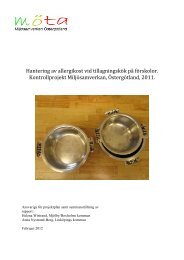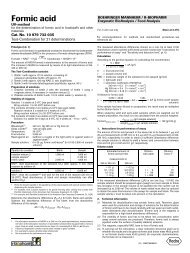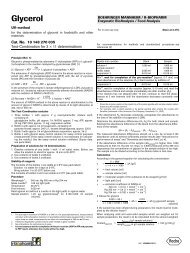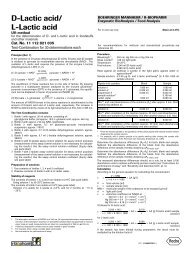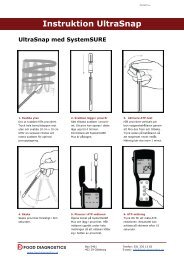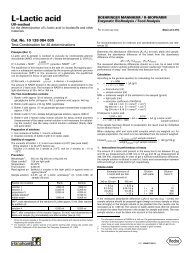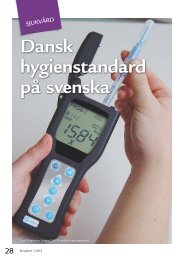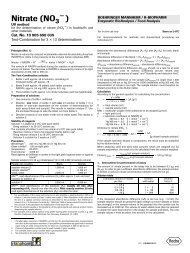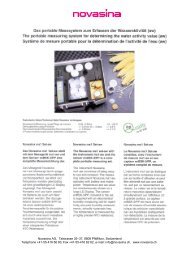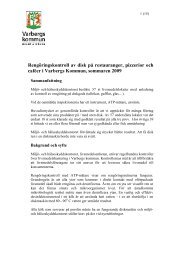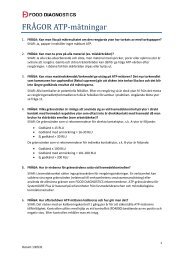Succinic acid - Food Diagnostics AB
Succinic acid - Food Diagnostics AB
Succinic acid - Food Diagnostics AB
Create successful ePaper yourself
Turn your PDF publications into a flip-book with our unique Google optimized e-Paper software.
Dilution tableEstimated amount ofsuccinic <strong>acid</strong> per liter 0.4 g0.4-4.0 g4.0-40 g> 40 gDilutionwith water-1 + 91 + 991 + 999Dilutionfactor F1101001000If the measured absorbance difference (A) is too low (e.g. 0.100), thesample solution should be prepared again (weigh out more sample or diluteless strongly) or the sample volume to be pipetted into the cuvette can beincreased up to 2.000 ml. The volume of water added must then be reducedto obtain the same final volume in the assays for sample and blank. The newsample volume v must be taken into account in the calculation.2. Technical information2.1 Sample preparation with concentrated Carrez-solutions hasproved beneficial in the analysis of liquid whole egg and wholeegg powder (see ref. 2.1). The sample solution can also be usedfor the determination of D-3-hydroxybutyric <strong>acid</strong> and L-lactic<strong>acid</strong>.2.2 In carrying out the calculation, a clear indication should be given as towhether the results are to be given as succinic <strong>acid</strong> (molar mass 118.09g/mol) or as succinate (molar mass 116.07g/mol). (In enzymatic determinations,the succinate ion is measured.)3. Specificity (Ref. 1)Succinyl-CoA synthetase reacts not only with succinic <strong>acid</strong> but also withitaconic <strong>acid</strong>. In comparison to succinic <strong>acid</strong> the content of itaconic <strong>acid</strong> infoodstuffs is very low. Therefore, this fact is unimportant for the determinationof succinic <strong>acid</strong>.In the analysis of commercial succinic <strong>acid</strong>, results of approx. 100 % have toexpected.4. Sensitivity and detection limit (Ref. 1.2)The smallest differentiating absorbance for the procedure is 0.005absorbance units. This corresponds to a maximum sample volume v =2.000 ml and measurement at 340 of a succinic concentration of 0.15 mg/lsample solution (if v = 0.100 ml, this corresponds to 3mg/l sample solution).The detection limit of 0.6 mg/l is derived from the absorbance difference of0.020 (as measured at 340 nm) and a maximum sample volume v = 2.000 ml.5. LinearityLinearity of the determination exists from approx. 1 g succinic <strong>acid</strong>/assay(0.6 mg succinic <strong>acid</strong>/l sample solution; sample volume v = 2.000 ml) to 40 gsuccinic <strong>acid</strong>/assay (0.4 g succinic <strong>acid</strong>/l sample solution; sample volumev = 0.100 ml).6. PrecisionIn a double determination using one sample solution, a difference of 0.005 to0.010 absorbance units may occur. With a sample volume of v = 0.100 mland measurement at 340 nm, this corresponds to a succinic <strong>acid</strong> concentrationof approx. 3-6 mg/l. (If the sample is diluted during sample preparation, theresult has to be multiplied by the dilution factor F. If the sample is weighed infor sample preparation, e.g. using 1 g sample/100 ml = 10 g/l, a difference of0.03-0.06 g/100 g can be expected.)The following data have been published in the literature:CV = 0.98-1.4 % n = 15 in series (Ref. 1.2)Whole egg powder:x = 11 mg/kg r = 06.8 mg/kg s (r) = ± 2.4 mg/kgR = 12.1 mg/kg s (R) = ± 4.3 mg/kg (Ref. 2.1)7. Interference/sources of errorFumaric <strong>acid</strong> reacts with SCS, although very slowly with a creep reactionunder the aforementioned conditions. This can be eliminated by mathematicalextrapolation as usual.The presence of “NADH oxidases” in the assay system as well as thetendency of succinyl-CoA for hydrolysis (especially under alkaline conditions)leads to creep reactions. If the absorbance of blank and sample is readimmediately one after the other, extrapolation of the absorbance values backto the time of the addition of suspension 4 (SCS) is not necessary.8. Recognizing interference during the assay procedure8.1 If the conversion of succinic <strong>acid</strong> has been completed according to thetime given under “Procedure“, it can be concluded in general that nointerference has occurred.8.2 On completion of the reaction, the determination can be restarted byadding succinic <strong>acid</strong> (qualitative or quantitative): if the absorbance isaltered subsequent to the addition of the standard material, this is alsoan indication that no interference has occurred.8.3 Operator error or interference of the determination through thepresence of substances contained in the sample can be recognized bycarrying out a double determination using two different samplevolumes (e.g. 0.100 ml and 0.200 ml): the measured differences inabsorbance should be proportional to the sample volumes used.When analyzing solid samples, it is recommended that differentquantities (e.g. 1 g and 2 g) be weighed into 100 ml volumetric flasks.The absorbance differences measured and the weights of sample usedshould be proportional for identical sample volumes.8.4 Possible interference caused by substances contained in the samplecan be recognized by using an internal standard as a control: in additionto the sample, blank and standard determinations, a further determinationshould be carried out with sample and assay control solution in thesame assay. The recovery can then be calculated from the absorbancedifferences measured.8.5 Possible losses during the determination can be recognized by carryingout recovery tests: the sample should be prepared and analyzed withand without added standard material. The additive should be recoveredquantitatively within the error range of the method.9. Reagent hazardThe reagents used in the determination of succinic <strong>acid</strong> are not hazardousmaterials in the sense of the Hazardous Substances Regulations, theChemicals Law or EC Regulation 67/548/EEC and subsequent alteration,supplementation and adaptation guidelines. However, the general safetymeasures that apply to all chemical substances should be adhered to.After use, the reagents can be disposed of with laboratory waste, but localregulations must always be observed. Packaging material can be disposedof in waste destined for recycling.10. General information on sample preparationIn carrying out the assay:Use clear, colorless and practically neutral liquid samples directly, orafter dilution according to the dilution table, and of a volume up to 2.000 ml;Filter turbid solutions;Degas samples containing carbon dioxide (e.g. by filtration);Adjust <strong>acid</strong> samples to pH 8-9 by adding sodium or potassium hydroxidesolution;Adjust <strong>acid</strong> and weakly colored samples to pH 8-9 by adding sodium orpotassium hydroxide solution and incubate for approx. 15 min;Treat “strongly colored” samples that are used undiluted or with a highersample volume with polyvinylpolypyrrolidone (PVPP) - (e.g. 1 g/100 ml);Crush or homogenize solid or semi-solid samples, extract with water ordissolve in water and filter if necessary; resp. remove turbidities or dyestuffsby Carrez clarification;Deproteinize samples containing protein with perchloric <strong>acid</strong>, alternativelyclarify with Carrez reagent;Extract samples containing fat with hot water (extraction temperatureshould be above the melting point of the fat involved). Cool to allow the fatto separate, make up to the mark, place the volumetric flask in an ice bathfor 15 min and filter; alternatively clarify with Carrez-solutions after theextraction with hot water.Carrez clarification:Pipette the liquid sample into a 100 ml volumetric flask which containsapprox. 60 ml redist. water, or weigh sufficient quantity of the sample into a100 ml volumetric flask and add approx. 60 ml redist. water. Subsequently,carefully add 5 ml Carrez-I-solution (potassium hexacyanoferrate(II) (ferrocyanide),85 mM = 3.60 g K 4 [Fe(CN) 6 ] × 3 H 2 O/100 ml) and 5 ml Carrez-IIsolution(zinc sulfate, 250 mM = 7.20 g ZnSO 4 × 7 H 2 O/100 ml). Adjust to pH7.5-8.5 with sodium hydroxide (0.1 M; e.g. 10 ml). Mix after each addition. Fillthe volumetric flask to the mark, mix and filter.Preparation of egg and egg product samples is dealt with in pt. 11 (applicationexamples). Note: Treatment with concentrated Carrez-solutions has provedbeneficial in routine analysis. In Germany, the method has been standardizedand published in § 35 of the <strong>Food</strong>stuffs and Consumer Goods Law(Lebensmittel- and Bedarfsgegenständegesetz, LMBG). The sample solutionresulting from Carrez clarification can also be used for the determination ofD-3-hydroxybutyric <strong>acid</strong> and of L-lactic <strong>acid</strong>.11. Application examplesDetermination of succinic <strong>acid</strong> in wine<strong>Succinic</strong> <strong>acid</strong> can be determined in white or red wine normally withoutprevious dilution or decolorization. Use 0.100 ml of the sample for the assay.Determination of succinic <strong>acid</strong> in soy sauceAdd 2 ml diluted Carrez-I-solution (3.60 g potassium hexacyanoferrate(II),K 4 [Fe(CN) 6 ] × 3 H 2 O/100 ml) to 1 ml soy sauce and swirl gently. After addi-2



